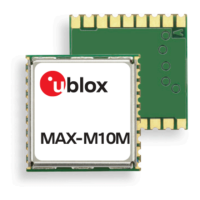MAX-M10M-Integration manual
changed, it is recommended to save the antenna supervisor configuration to BBR to ensure that
the updated configuration is applied after a reset.
Configuration keys Physical antenna state Reported antenna status
VOLTCTRL SHORTDET OPENDET PWRDOWN RECOVER Short circuit Open circuit antPower antStatus
TRUE X X X X NO NO ON OK
TRUE FALSE X X X X NO
TRUE X FALSE X X NO X
TRUE FALSE FALSE X X X X
TRUE FALSE TRUE X X X YES ON OPEN
TRUE X TRUE X X NO YES
TRUE TRUE X FALSE X YES X ON SHORT
TRUE TRUE X TRUE X YES X OFF SHORT
FALSE TRUE X X X YES X UNKNOWN SHORT
FALSE FALSE TRUE X X X YES UNKNOWN OPEN
FALSE X TRUE X X NO YES UNKNOWN OPEN
Table 20: Antenna supervisor configuration and antenna states
3.4 Forcing receiver reset
GNSS receivers typically make a distinction between cold, warm, and hot start based on the type of
valid information the receiver has during the restart.
• Cold start: in the cold start mode, the receiver has no information from the last position (e.g.
time, velocity, frequency etc.) at startup. Therefore, the receiver must search the full time and
frequency space, and all possible satellite numbers. If a satellite signal is found, it is tracked
to decode the ephemeris (18-36 seconds under strong signal conditions), while the other
channels continue to search satellites. Once there is a sufficient number of satellites with
valid ephemeris, the receiver can calculate position and velocity data. Other GNSS receiver
manufacturers call this the Factory startup mode.
• Warm start: in the warm start mode, the receiver has approximate information for time,
position, and coarse satellite position data (Almanac). In this mode, the receiver normally needs
to download ephemeris after power-up before it can calculate position and velocity data. As the
ephemeris data is usually outdated after 4 hours, the receiver typically starts with a warm start
if it has been powered down for more than 4 hours. In this scenario, several augmentations are
possible. See Multiple GNSS assistance.
• Hot start: in the hot start mode, the receiver has been powered down only for a short time (4
hours or less), so that its ephemeris is still valid. Since the receiver does not need to download
ephemeris again, this is the fastest startup method.
Using the UBX-CFG-RST message, you can force the receiver to reset and clear data, in order to see
the effects of maintaining/losing such data between restarts. For this purpose, use the navBbrMask
field in the UBX-CFG-RST message to initiate hot, warm, and cold starts, or a combination of startup
modes.
The reset type can also be specified. This is not related to GNSS, but to the way the software restarts
the system.
• Hardware reset uses the on-chip watchdog to electrically reset the chip. This is an immediate
asynchronous reset. No stop events are generated.
UBX-22038241 - R02
3 Receiver functionality Page 34 of 92
C1-Public

